化学专业英语课文翻译
- 格式:pdf
- 大小:322.42 KB
- 文档页数:14
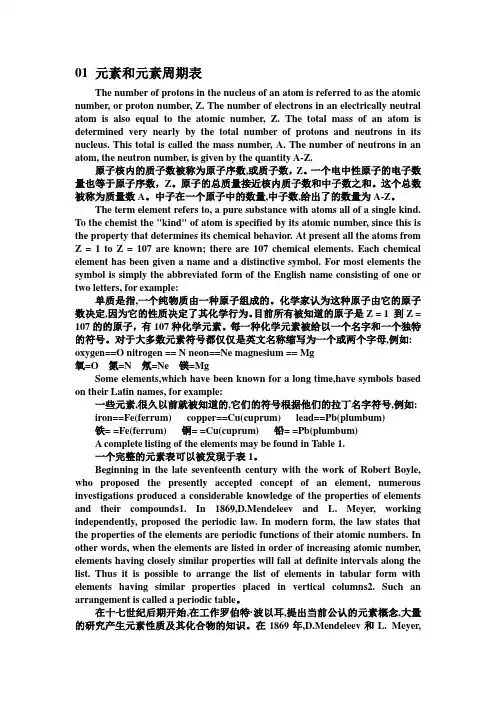
01 元素和元素周期表The number of protons in the nucleus of an atom is referred to as the atomic number, or proton number, Z. The number of electrons in an electrically neutral atom is also equal to the atomic number, Z. The total mass of an atom is determined very nearly by the total number of protons and neutrons in its nucleus. This total is called the mass number, A. The number of neutrons in an atom, the neutron number, is given by the quantity A-Z.原子核内的质子数被称为原子序数,或质子数,Z。
一个电中性原子的电子数量也等于原子序数,Z。
原子的总质量接近核内质子数和中子数之和。
这个总数被称为质量数A。
中子在一个原子中的数量,中子数,给出了的数量为A-Z。
The term element refers to, a pure substance with atoms all of a single kind. To the chemist the "kind" of atom is specified by its atomic number, since this is the property that determines its chemical behavior. At present all the atoms from Z = 1 to Z = 107 are known; there are 107 chemical elements. Each chemical element has been given a name and a distinctive symbol. For most elements the symbol is simply the abbreviated form of the English name consisting of one or two letters, for example:单质是指,一个纯物质由一种原子组成的。
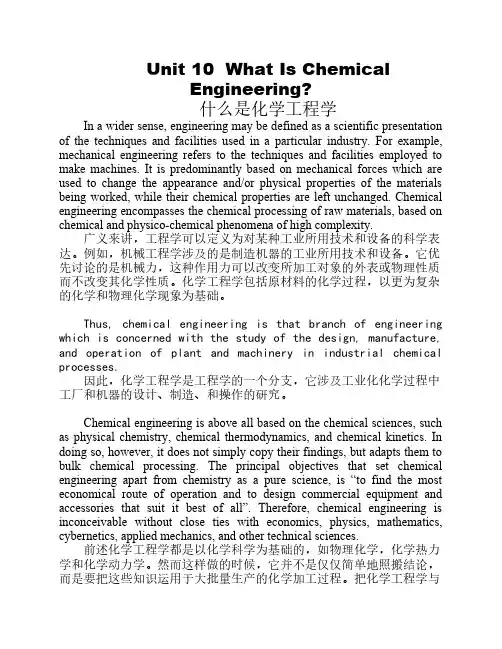
Unit 10 What Is ChemicalEngineering?什么是化学工程学In a wider sense, engineering may be defined as a scientific presentation of the techniques and facilities used in a particular industry. For example, mechanical engineering refers to the techniques and facilities employed to make machines. It is predominantly based on mechanical forces which are used to change the appearance and/or physical properties of the materials being worked, while their chemical properties are left unchanged. Chemical engineering encompasses the chemical processing of raw materials, based on chemical and physico-chemical phenomena of high complexity.广义来讲,工程学可以定义为对某种工业所用技术和设备的科学表达。
例如,机械工程学涉及的是制造机器的工业所用技术和设备。
它优先讨论的是机械力,这种作用力可以改变所加工对象的外表或物理性质而不改变其化学性质。
化学工程学包括原材料的化学过程,以更为复杂的化学和物理化学现象为基础。
Thus, chemical engineering is that branch of engineering which is concerned with the study of the design, manufacture, and operation of plant and machinery in industrial chemical processes.因此,化学工程学是工程学的一个分支,它涉及工业化化学过程中工厂和机器的设计、制造、和操作的研究。
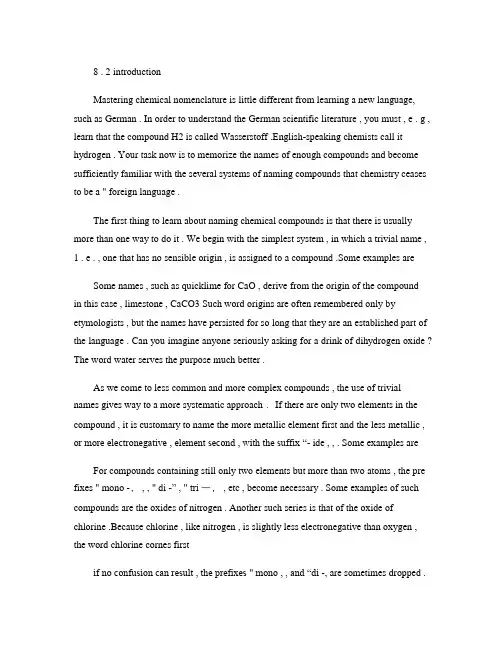
8 . 2 introductionMastering chemical nomenclature is little different from learning a new language, such as German . In order to understand the German scientific literature , you must , e . g , learn that the compound H2 is called Wasserstoff .English-speaking chemists call it hydrogen . Your task now is to memorize the names of enough compounds and become sufficiently familiar with the several systems of naming compounds that chemistry ceases to be a " foreign language .The first thing to learn about naming chemical compounds is that there is usually more than one way to do it . We begin with the simplest system , in which a trivial name , 1 . e . , one that has no sensible origin , is assigned to a compound .Some examples areSome names , such as quicklime for CaO , derive from the origin of the compoundin this case , limestone , CaCO3 Such word origins are often remembered only by etymologists , but the names have persisted for so long that they are an established part of the language . Can you imagine anyone seriously asking for a drink of dihydrogen oxide ? The word water serves the purpose much better .As we come to less common and more complex compounds , the use of trivial names gives way to a more systematic approach. If there are only two elements in the compound , it is customary to name the more metallic element first and the less metallic , or more electronegative , element second , with the suffix “- ide , , . Some examples areFor compounds containing still only two elements but more than two atoms , the pre fixes " mono -, , , " di -” , " tri 一, , etc , become necessary . Some examples of such compounds are the oxides of nitrogen . Another such series is that of the oxide of chlorine .Because chlorine , like nitrogen , is slightly less electronegative than oxygen , the word chlorine cornes firstif no confusion can result , the prefixes " mono , , and “di -, are sometimes dropped .A class of compounds in which such prefixes are seldom used is that in which the metal atom usually exhibits only one oxidation state Depending on the oxidation state of the other element , the number of anions per cation is then fixed . Some examples areThe next level of complexity in naming Inorganic compounds arises when there are three elements present . Very often , one of these elements is oxygen . Such compounds are named by combining the suffix “ ate “ , with the name of the less electronegative of the two nonmetallic elements. For example , NaNo3 is sodium nitrate . The problem with this is that there is a similar compound with nitrogen in the + 3 oxidation state , NaNO2. such compounds with the element in a lower oxidation state use the suffix “-ite , , , so NaNO2 is sodium nitrite . But the number of chemical compounds is not bounded by the chemists ' vocabulary , and there are several such examples entailing more than two oxidation states .To solve this problem , the prefix ' ' hy - po 一, , ( meaning " below , , is used in the name of the compound In which the less electronegative element is in the lowest oxidation state , and the prefix " per-, , ( meaning " highest , , is usedwhen it is in the highest oxidation state Some examples of the use of this system are shown In the following table ( Table 8 . 2In the inorganic acids , the suffixes “-ous , , and "- ic , , are used to denote the lower and higher oxidation states , respectively These same suffixes are also used with the names of a number of metals , namely , those that usually exhibit more than one oxidation state Some examples are cobaltous and cobaltic , and mercurous and mercuric . The nomenclature is complicated slightly by the fact that , for a few such metals , these terms are derived from the Latin name of the element rather than the English name .All but eleven of the elements are given a symbol corresponding to one or two letters In the English name of the compound ( The first letter is always capitalized and the second letter 15 never capitalized One of these exceptions is tungsten , whose symbol ( W is derived from the German name of the element , Wolfram The other ten havesymbols derived from their Latin names . These are , stibium ( Sb for antimony , cuprum ( Cu )for copper , aurum ( Au for gold ,ferrum ( Fe for iron , plumbum ( Pb for lead , hydrargyrum ( Hg for mercury , kalium ( K for potassium , argentum ( Ag for silver , natrium ( Na for sodium , and stannum ( Sn for tin. The use of the suffixes ' ’- ous , , and “-ic , , with three of these metals 15 illustrated belowThe system works well as long as there are only two major oxidation states of the metal atom , as in those examples .The most rational and selfconsistent system of nomenclature of inorganic compounds is that adopted in 1957 by the ultimate authority in such matters , the International Union of Pure and Applied Chemistry. these rules , popularly called the IUPAC Rules , are the model for chemists throughout the world to follow , and are becoming ever more dominant In the chemical literature . Note that the oxidation state of the metal atom is specified by a Roman numeral whenever there could be some doubt about it , but not otherwise Let us see how the examples shown above are named according to this system掌握化学命名是学习新的语言,如德国略有不同。
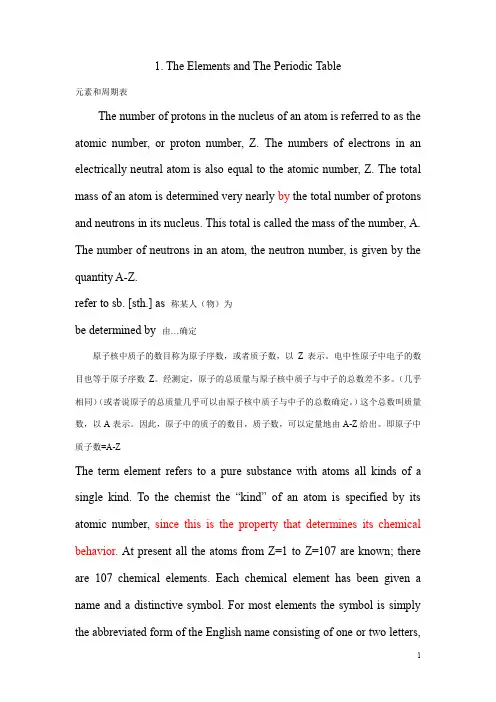
1. The Elements and The Periodic Table元素和周期表The number of protons in the nucleus of an atom is referred to as the atomic number, or proton number, Z. The numbers of electrons in an electrically neutral atom is also equal to the atomic number, Z. The total mass of an atom is determined very nearly by the total number of protons and neutrons in its nucleus. This total is called the mass of the number, A. The number of neutrons in an atom, the neutron number, is given by the quantity A-Z.refer to sb. [sth.] as 称某人(物)为be determined by 由…确定原子核中质子的数目称为原子序数,或者质子数,以Z表示。
电中性原子中电子的数目也等于原子序数Z。
经测定,原子的总质量与原子核中质子与中子的总数差不多。
(几乎相同)(或者说原子的总质量几乎可以由原子核中质子与中子的总数确定。
)这个总数叫质量数,以A表示。
因此,原子中的质子的数目,质子数,可以定量地由A-Z给出。
即原子中质子数=A-ZThe term element refers to a pure substance with atoms all kinds of a single kind. To the chemist the “kind” of an atom is specified by its atomic number, since this is the property that determines its chemical behavior. At present all the atoms from Z=1 to Z=107 are known; there are 107 chemical elements. Each chemical element has been given a name and a distinctive symbol. For most elements the symbol is simply the abbreviated form of the English name consisting of one or two letters,for example:元素这个术语指的是仅仅由同一种类的原子组成的物质。
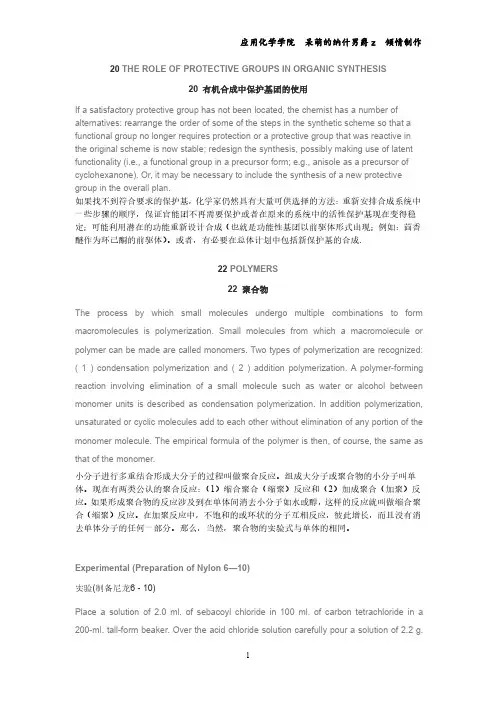
20THE ROLE OF PROTECTIVE GROUPS IN ORGANIC SYNTHESIS20有机合成中保护基团的使用If a satisfactory protective group has not been located,the chemist has a number of alternatives:rearrange the order of some of the steps in the synthetic scheme so that a functional group no longer requires protection or a protective group that was reactive in the original scheme is now stable;redesign the synthesis,possibly making use of latent functionality(i.e.,a functional group in a precursor form;e.g.,anisole as a precursor of cyclohexanone).Or,it may be necessary to include the synthesis of a new protective group in the overall plan.如果找不到符合要求的保护基,化学家仍然具有大量可供选择的方法:重新安排合成系统中一些步骤的顺序,保证官能团不再需要保护或者在原来的系统中的活性保护基现在变得稳定;可能利用潜在的功能重新设计合成(也就是功能性基团以前驱体形式出现;例如:茴香醚作为环己酮的前驱体)。
或者,有必要在总体计划中包括新保护基的合成.22POLYMERS22聚合物The process by which small molecules undergo multiple combinations to form macromolecules is polymerization.Small molecules from which a macromolecule or polymer can be made are called monomers.Two types of polymerization are recognized: (1)condensation polymerization and(2)addition polymerization.A polymer-forming reaction involving elimination of a small molecule such as water or alcohol between monomer units is described as condensation polymerization.In addition polymerization, unsaturated or cyclic molecules add to each other without elimination of any portion of the monomer molecule.The empirical formula of the polymer is then,of course,the same as that of the monomer.小分子进行多重结合形成大分子的过程叫做聚合反应。
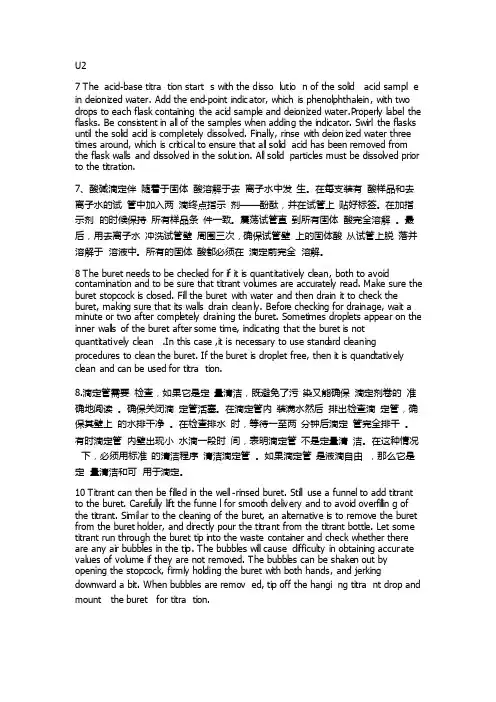
U27 The acid-base titration starts with the dissolution of the solid acid sample in deioni zed water. Add the end-pointindica tor, whichis phenol phtha lein, with two dropsto each flaskcontai ningthe acid sample and deioni zed water.Proper ly labelthe flasks. Be consis tentin all of the sample s when adding the indica tor. Swirlthe flasks untilthe solidacid is comple telydissol ved. Finall y, rinsewith deioni zed waterthreetimesaround, whichis critic al to ensure that all solidacid has been remove d from the flaskwallsand dissol ved in the soluti on. All solidpartic les must be dissol ved priorto the titrat ion.7、酸碱滴定伴随着于固体酸溶解于去离子水中发生。
在每支装有酸样品和去离子水的试管中加入两滴终点指示剂——酚酞,并在试管上贴好标签。
在加指示剂的时候保持所有样品条件一致。
震荡试管直到所有固体酸完全溶解。
最后,用去离子水冲洗试管壁周围三次,确保试管壁上的固体酸从试管上脱落并溶解于溶液中。
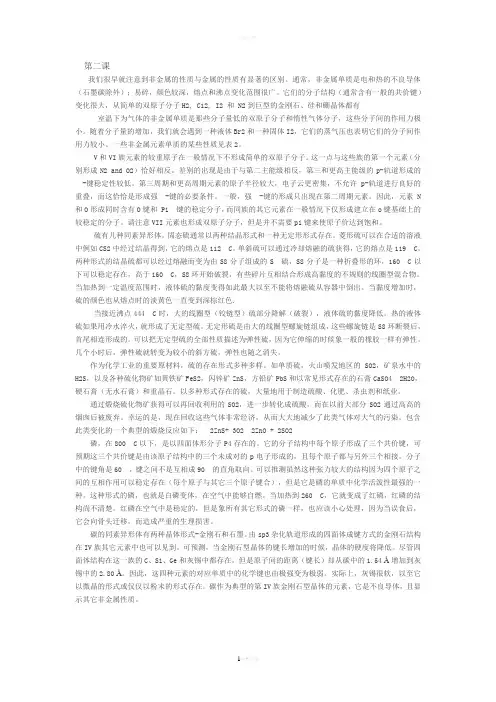
第二课我们很早就注意到非金属的性质与金属的性质有显著的区别。
通常,非金属单质是电和热的不良导体(石墨碳除外);易碎,颜色较深,熔点和沸点变化范围很广。
它们的分子结构(通常含有一般的共价键)变化很大,从简单的双原子分子H2, C12, I2 和 N2到巨型的金刚石、硅和硼晶体都有室温下为气体的非金属单质是那些分子量低的双原子分子和惰性气体分子,这些分子间的作用力极小。
随着分子量的增加,我们就会遇到一种液体Br2和一种固体I2,它们的蒸气压也表明它们的分子间作用力较小。
一些非金属元素单质的某些性质见表2。
V和VI族元素的较重原子在一般情况下不形成简单的双原子分子。
这一点与这些族的第一个元素(分别形成N2 and O2)恰好相反。
差别的出现是由于与第二主能级相反,第三和更高主能级的p-轨道形成的-键稳定性较低。
第三周期和更高周期元素的原子半径较大,电子云更密集,不允许p-轨道进行良好的重叠,而这恰恰是形成强-键的必要条件。
一般,强-键的形成只出现在第二周期元素。
因此,元素N 和O形成同时含有O键和 Pi 键的稳定分子,而同族的其它元素在一般情况下仅形成建立在o键基础上的较稳定的分子。
请注意VII元素也形成双原子分子,但是并不需要pi键来使原子价达到饱和。
硫有几种同素异形体。
固态硫通常以两种结晶形式和一种无定形形式存在。
菱形硫可以在合适的溶液中例如CS2中经过结晶得到,它的熔点是112C。
单斜硫可以通过冷却熔融的硫获得,它的熔点是119C。
两种形式的结晶硫都可以经过熔融而变为由S8分子组成的S硫,S8分子是一种折叠形的环,160C以下可以稳定存在,高于160C,S8环开始破裂,有些碎片互相结合形成高黏度的不规则的线圈型混合物。
当加热到一定温度范围时,液体硫的黏度变得如此最大以至不能将熔融硫从容器中倒出。
当黏度增加时,硫的颜色也从熔点时的淡黄色一直变到深棕红色.当接近沸点444C时,大的线圈型(铰链型)硫部分降解(破裂),液体硫的黏度降低。
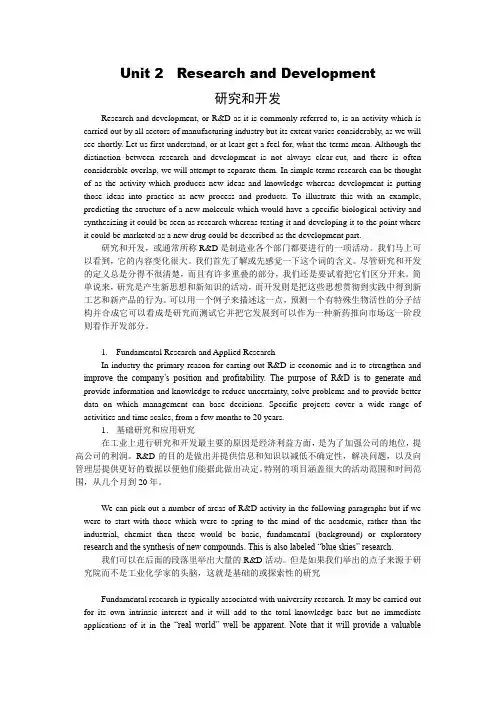
Unit 2 Research and Development研究和开发Research and development, or R&D as it is commonly referred to, is an activity which is carried out by all sectors of manufacturing industry but its extent varies considerably, as we will see shortly. Let us first understand, or at least get a feel for, what the terms mean. Although the distinction between research and development is not always clear-cut, and there is often considerable overlap, we will attempt to separate them. In simple terms research can be thought of as the activity which produces new ideas and knowledge whereas development is putting those ideas into practice as new process and products. To illustrate this with an example, predicting the structure of a new molecule which would have a specific biological activity and synthesizing it could be seen as research whereas testing it and developing it to the point where it could be marketed as a new drug could be described as the development part.研究和开发,或通常所称R&D是制造业各个部门都要进行的一项活动。
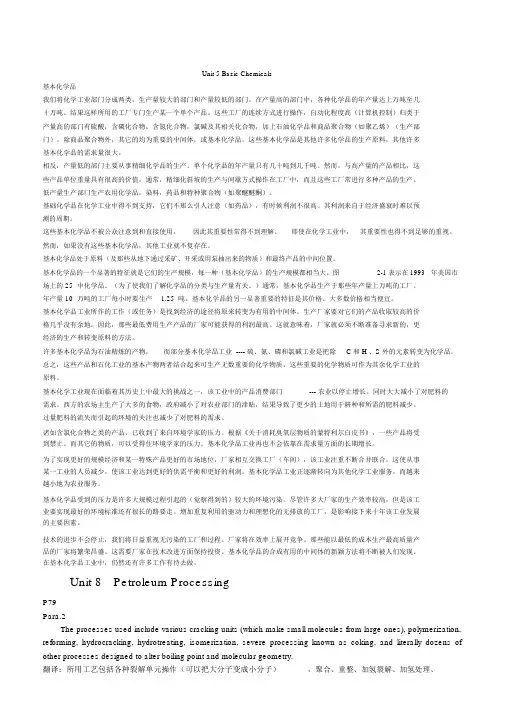
Unit 5 Basic Chemicals基本化学品我们将化学工业部门分成两类,生产量较大的部门和产量较低的部门。
在产量高的部门中,各种化学品的年产量达上万吨至几十万吨。
结果这样所用的工厂专门生产某一个单个产品。
这些工厂的连续方式进行操作,自动化程度高(计算机控制)归类于产量高的部门有硫酸,含磷化合物,含氮化合物,氯碱及其相关化合物,加上石油化学品和商品聚合物(如聚乙烯)(生产部门)。
除商品聚合物外,其它的均为重要的中间体,或基本化学品。
这些基本化学品是其他许多化学品的生产原料,其他许多基本化学品的需求量很大。
相反,产量低的部门主要从事精细化学品的生产。
单个化学品的年产量只有几十吨到几千吨。
然而,与高产量的产品相比,这些产品单位重量具有很高的价值。
通常,精细化斜坡的生产与间歇方式操作在工厂中,而且这些工厂常进行多种产品的生产。
低产量生产部门生产农用化学品,染料,药品和特种聚合物(如聚醚醚酮)。
基础化学品在化学工业中得不到支持,它们不那么引人注意(如药品),有时候利润不很高。
其利润来自于经济盛衰时难以预测的周期。
这些基本化学品不被公众注意到和直接使用,因此其重要性常得不到理解。
即使在化学工业中,其重要性也得不到足够的重视。
然而,如果没有这些基本化学品,其他工业就不复存在。
基本化学品处于原料(及那些从地下通过采矿、开采或用泵抽出来的物质)和最终产品的中间位置。
基本化学品的一个显著的特征就是它们的生产规模,每一种(基本化学品)的生产规模都相当大。
图2-1 表示在 1993年美国市场上的 25中化学品。
(为了使我们了解化学品的分类与生产量有关。
)通常,基本化学品生产于那些年产量上万吨的工厂。
年产量 10万吨的工厂每小时要生产 1.25 吨。
基本化学品的另一显著重要的特征是其价格。
大多数价格相当便宜。
基本化学品工业所作的工作(或任务)是找到经济的途径将原来转变为有用的中间体。
生产厂家要对它们的产品收取较高的价格几乎没有余地,因此,那些最低费用生产产品的厂家可能获得的利润最高。
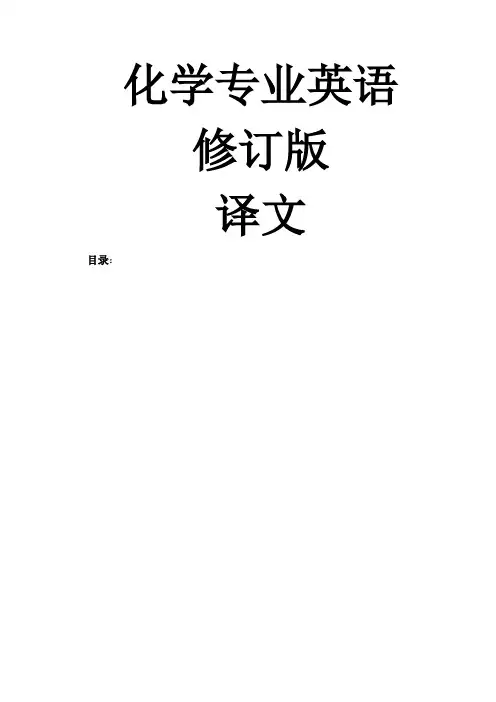
化学专业英语修订版译文目录:1、THE ELEMENTS AND THE PERIODIC TABLE元素和周期表在原子核中质子的数目被称为原子序数,或质子数,Z;电中性原子中的电子数目也等于原子序数,Z;一个原子的总质量几乎由它的原子核中的质子和中子的总数所决定;此总量称为质量数,A;原子中中子的数目,中子数,其值由下式给出:A-Z;元素这一术语指的是,由单一种类的原子所组成的纯物质;对化学家来说“类”是由其原子序数指定的,因为这是个决定了它的化学行为的属性;目前,所有的原子从Z = 1,Z = 107都为人所知了;共有107种化学元素;每个化学元素被赋予一个名称和一个特定的符号;对于大多数的元素来说符号是简单的英文名称的缩写,由一个或两个字母组成,例如:氧==O 氮== N 氖==Ne 镁==Mg已经为人所知了很长一段时间的一些元素,其符号是基于其拉丁语中的名称,例如:铁==Feferrum铜==Cucuprum铅==Pbplumbum在表1中可以找到的元素的完整列表;早在17世纪末期,罗伯特.波义尔就开始了这项工作,他提出了现在公认的元素概念,大量的研究使我们对元素及其化合物的性质有了相当的研究;1869年,和,各自通过独立的工作,提出了周期性规律;在现代的形式中,该规律表明元素的属性和原子序数呈周期性的函数关系;换句话说,当元素依照原子序数的升序排列时,具有大致相同的特性的元素将沿着列表中的一定间隔降序排列;因此,将具有类似性质的元素排成纵列,从而将元素排成表格的形式是可能的;这种安排被称为一个周期表;每个一行中的元素构成一个周期;应当指出的是周期表的长度是变化的;有一个很短的周期只由2个元素组成,随后的两个周期各有8个元素,接下来的两个长周期各有18个元素;再接下来的一个周期包括32个元素,最后一个周期显然是不完整的;这样的安排,使得相同的垂直列中的元素具有类似的特性;这些列构成的化学族或群;那些以两个八元素周期为首的族中的元素被指定为主族元素,和其他各组的成员被称为过渡或内过渡元素;在周期表中,一条重重的阶梯线把元素们划分成金属和非金属;这条线除氢外左侧的是金属元素,而在右边是非金属元素;这种划分只是为了方便;那些与分隔线邻近的元素——准金属,既有金属的性质,又有非金属的性质;可以看出,大部分的元素,包括所有的过渡与内过渡元素,是金属元素;除氢元素——一种气体元素外,IA族的元素组成了碱金属族;它们是非常活泼的金属,它们从未在自然界中以单质状态被发现;然而,它们的化合物是广泛分布的;碱金属族的所有成员,只能形成具有1 +价的离子;与此相反,IB族的元素铜,银,和金的元素相对来说是惰性的;它们和碱金属是相似的,因为它们在化合物中以1 +的离子存在;但是,和大多数过渡元素具有的特性一样,它们形成也能形成其它价的离子;IIA族的元素就是通常所说的碱土金属;它们离子的特征价态是2 +;这些金属,尤其是组中的最后两个元素,几乎和碱金属一样活泼; IIB组元素,锌,镉,和汞比那些IIA的元素活性低,但比邻近的IB族元素活泼;它们的特征离子价态也是2 +;除硼以外,第IIIA族元素也相当活泼的金属;铝与空气反应后是惰性的,但这一表现源于这一事实:在金属表面形成了一个薄的,不可见的铝的氧化膜,该膜保护大部分金属不会进一步氧化;IIIA族的金属形成3 +价的离子;IIIB族由金属钪,钇,镧和锕组成;第IVA族由一个非金属,碳,两个准金属,硅和锗和两种金属,锡和铅组成;这些元素中的每一个都形成一些化合物,这些化合物的分子式表明四个其它的原子出现在每个IVA族原子周围;例如,四氯化碳,CCl4; IVB族金属——钛,锆和铪,也形成每个IVB族原子与四个其它原子结合的化合物,这些化合物纯的时候是非电解质;VA族的元素包括三个非金属元素——氮,磷,砷和两个金属——锑和铋;尽管它们存在分子式为N2O5,PCL5,和AsCl5的化合物,但它们都不是离子型化合物;这些元素形成的化合物——氮化物,磷化物和砷化物,其中离子的价态都是负三价; VB族的所有元素都是金属;这些元素形成这样的多种不同的化合物,它们的特点是不容易总结归纳的;除钋以外,VIA族元素是典型的非金属;他们有时也被称为硫族,来自希腊字,意思是“灰源体”;在他们与金属形成的二元化合物中它们以2-的离子价存在;ⅦA族的所有元素都是非金属元素,被称为卤素;来自希腊文,意思是“盐源体”;他们是最活泼的非金属,并能够与几乎所有的金属和大部分非金属,包括它们自己反应;ⅥB,ⅦB,VIIIB的所有元素都是金属;它们形成各种不同的化合物,在这一点上我们甚至不能举出任何能表现各族元素典型变化的例子;化学行为的周期性可以通过这样的事实阐明:不包括第一个周期,每个周期的开始,是一个非常活泼的金属;周期中的连续元素,金属性逐渐降低,最终成为非金属,最后,在ⅦA族,一个非常活泼的非金属就出现了;每个周期以惰性气体家族的一个成员结束;-------------------------------------------------------------------6、THE CLASSIFICATION OF INORGANIC COMPOUNDS无机化合物的分类化合物的分类今天成千上万的化合物已被化学家所认识;如果根据个别化合物来了解这么多化合物的性质和行为,即使其中的很小一部分也不可能;所幸的是,大多数化合物可以被归为几类;这样,如果我们能正确地对一个化合物进行分类,就可以根据已知这类化合物的性质知道这个化合物的一般性质;例如,盐酸是一种酸,因为已经熟悉酸的性质,我们就可以立即知道这一化合物的一般性质;我们学过的大多化合物可以分为酸,碱,盐,金属氧化物,非金属氧化物;在这5类化合物中,前3种—酸,碱,盐—是最重要的;如果一种酸,碱或盐溶于水中形成的溶液是电流的导体,就被称为电解质;如果没有电流产生则此化合物是非电解质;普通化合物的分类通过观察化学式我们可以将许多普通化合物分类如下:⒈⒉通常碱中存在的氢氧根写在分子式的后面;分子式的前面一般是金属;例如,OHOH3;⒊盐由金属组成,写在前面,结合非金属或基团,写在化学式的后面;如SOClO2;⒋氧化物仅包括氧和其它一种元素;如果这种元素除了氧以外是非金属,这种氧化物称为非金属或酸酐;酸酐的命名是因为在特定的条件下将水溶液加入到非金属氧化物中会生成酸;同样,如果水从含氧酸中被转移走就会生成酸酐;另一类氧化物,金属氧化物或碱酐,由氧结合金属组成;当在适当的条件下将水加入到碱酐中,有碱生成,反之亦然;酸按传统的观念,所有的酸都包含H,它可以被金属取代;在酸分子中负价的基团由非金属或基团组成负价基团;这些负价的基团被称为酸根除了氧和氢氧根;所有的酸都是共价化合物,它们的原子通过共用电子连接;当酸溶于水时,由于酸中的氢离子转移到水分子中所以形成离子——例如:H ‥‥‥‥ H﹕Cl﹕+H﹕O﹕H→H﹕O﹕H++﹕Cl﹕-这是一种配位价,水中未成对的电子结合氢离子形成水合离子;水合离子是水合物H+ 或称质子,根据这种形式酸在水溶液中电离时,我们可以利用简单的H+来写方程式;此方程式变得简单而且容易配平;酸的主要性质是提供H+的能力,因此,我们把能够提供H+的物质定义为酸; 酸的性质,一般来说,酸的水溶液的性质如下:⒈它们都有酸味;柠檬,桔子以及其它的柠檬水果由于柠檬酸的存在而具有酸味;酸奶的酸味也是因为乳酸的存在;⒉它可以使蓝石蕊变红;石蕊是一种染料,它在酸溶液中显红色,在碱溶液中显蓝色;将纸浸泡在石蕊中制成石蕊试纸;这类物质,能够确定所给的溶液是酸还是碱,我们称之为指示剂;甲基橙和酚酞是其它两种常用的指示剂;⒊它可以和某些金属反应生成氢气;这类反应经常被用来制氢气;⒋它和碱反应生成盐和水;一般的强酸有硫酸,硝酸,盐酸,氢溴酸和氢碘酸;其它的一些酸仅仅部分电离从而仅仅是中强酸或弱酸;碱所有金属的氢氧化物被分类于碱类;一般的碱如氢氧化钠,氢氧化钾,氢氧化钙和氢氧化钡可以溶于水中;如果这些化合物可以溶解于水中,所有的溶液中都会有OH- ;氨的水溶液也属于碱类,因为溶液中存在OH-;每种这类化合物都是由金属或铵根离子结合氢氧根离子形成的;正如显示酸特性的部分是H+,因此显示碱特性的部分是OH-;因此碱的概念就扩展为不能提供质子的物质; 碱的性质;一般来说金属氢氧化物的水溶液显示出以下的性质:⒈味道苦;⒉具有滑腻性;⒊可以使红色石蕊变蓝;⒋和酸生成盐和水;⒌大多数金属氢氧化物都是可溶的;一般情况下氢氧化钠,氢氧化钾,氢氧化钙,氢氧化钡和氨是可溶的;一般的强碱有氢氧化钠,氢氧化钾,氢氧化钙和氢氧化钡;盐酸和碱反应生成盐和水;酸中的氢离子结合碱中的氢氧根离子形成水分子;酸和碱的反应是中和反应;如果在反应后所有的水通过蒸发移走,碱中的正离子和酸中的负离子形成晶格的固体;证据显示化合物氯化钠,一种盐,是一种电价的化合物,可以在固体或晶体状态下电离;这种晶体由钠离子和氯离子通过定向模式组成的;一般来讲,大多数盐在晶体状态下是电价的;由定向离子通过确定的方法组成;-------------------------------------------------------------------7、The Nomenclature of Inorganic Compounds无机化合物的命名随着上千种新无机化合物的发现,我们有必要修改传统命名的规则;国际委员会已经推荐了一套化合物命名的规则,并且现在世界各地都采用了;许多旧的名字仍然在使用,但是我们将讨论新旧规则的许多例子,但以新规则为讨论重点;其中主要的变化就是被Albert Stock提出的为一些存在多种氧化态的金属的化合物氧化物、氢氧化物、盐命名的Stock方法;在这种情况下,金属氧化态是紧接着金属的英语名称之后在圆括号中用罗马数字表示,该数字与金属的氧化数一致;如果金属只有一个常见的氧化数,则不使用罗马数字;另一个重要的变化是在命名复杂的离子和配位化合物;我们推迟后者的命名直到我们讨论这些化合物;金属氧化物、酸碱、盐的命名一个学生如果掌握了给出离子电荷和较常见离子名称的价表3,他在掌握命名方面就必定有了一个好的开端;阴阳离子以恰当的比例来平衡电荷组成了化合物,并且化合物的名字来自于离子的名称,例如NaCl叫氯化钠;AlOH3叫氢氧化铝,FeBr2叫溴化铁Ⅱ或者溴化亚铁;CaC2H3O22叫乙酸钙,Cr2SO43叫硫酸铬Ⅲ或者硫酸铬,等等;表4给出一些额外金属化合物命名的例子;两种常见的系统被使用时,Stock系统是首选;注意的是,即使在这个系统中,然而阴离子的名称仍需要查化合价表4;带负电荷的离子,阴离子,可能是单原子的或者是多原子的;所有单原子的阴离子都有以 ide结尾的名字;氢氧根离子OH-和氰根离子CN-的两个多原子离子也有以ide结尾的名字;许多多原子离子除了其他元素还包含了氧元素;在这些含氧阴离子中氧原子的数量以后缀ite和ate来表示,ite和ate分别意味着较少和较多的氧原子;在某些情况下,有必要表示多于两个相同元素的氧阴离子,分别表示更少和更多氧原子的前缀hypo和per 可能被使用;一系列的氧阴离子被命名在表5中;非金属氧化物的命名仍被广泛使用的旧的命名系统使用希腊语前缀表示氧原子的数目和化合物中其他的元素;被使用的前缀有lmono-, 有时简称成 mon-, 2di-, 3tri-, 4tetra-, 5penta-, 6 hexa-, 7hepata-, 8octa-, 9nona-and 10deca-;当命名一个非金属氧化物时,渐渐地的字母a在前缀中被省略tetra并且常常mono-在所有的名称中也一起被省略;Stock系统也被用于非金属氧化物,这里的罗马数字指的是除了氧元素其他元素的氧化态;在两个系统中,除了氧元素的其他元素被首先命名,整个名称后面加上一个OXide;表6中展示了一些例子;酸的命名酸的名字可以直接从化合价表3的知识中得到,只要以下面表的形式改变酸离子阴离子的名字即可;表7展示了这种关系的例子;还有少数情况下,酸的名字可以由酸根稍稍的改变得到;例如:H2SO4是sulfuric而不是sulfic;相似的,H3PO4是phosphoric而不是phosphic;一些很少见的阴离子不包括在化合价表3中;例如:BO33-是硼酸根的离子并且H3PO3是硼酸;TeO42-是碲酸盐离子并且H2TeO4是碲酸,等等;酸式盐和碱式盐可以想象,在酸和碱的中和反应中,只有一部分氢离子被中和;因此NaOH + H2SO4-----→NaHSO4 + H2O化合物NaHSO4有酸的性质,因为它当中有氢离子,它也是一个盐,因为它既有金属阳离子有酸根;像这样的含酸性氢离子的盐叫做酸式盐;磷酸H3PO4可以逐渐的被中和成盐,NaH2PO4, Na2HPO4 和 Na3PO4;前两种是酸式盐,因为它们包含可置换的氢;一种命名这些盐的方法是把NaH2PO4叫做磷酸二氢钠,把Na2HPO4叫做磷酸氢二钠;这种算是磷酸盐在控制血液酸碱度方面起着重要作用;第三种化合物,磷酸钠Na3PO4,其中没有可置换的氢,通常被叫做正磷酸钠,或磷酸三钠用以区别前两种酸式盐;历史上,前缀bi-被用来命名一些酸式盐;在工业上,例如,NaHCO3被叫做碳酸氢钠而CaHSO32被叫做亚硫酸氢钙;因为bi-有点令人误解,故上面讨论的命名系统更可取;如果碱中的氢氧根逐渐被氢离子所中和,就很可能形成碱式盐:CaOH2 + HCl-----→CaOHCl + H2O碱式盐有碱的性质并且可以和酸反应生成正盐和水;OH基团是一个碱性基团叫做羟基集团;BiOH2NO3的名字叫做碱式硝酸铋;混盐如果酸中的氢被两种或两种以上不同的金属所替换,就形成了混盐;因此H2SO3中的两个氢原子被钠和钾取代从而生成混盐,NaKSO4硫酸氢钾;NaNH4HPO4是一个酸式混盐,它可以从尿中结晶出来;-------------------------------------------------------------------9、The coordination complex配位化合物配位化合物形成的化学基础是配位键,形成时必须有一个电子对受体和一个电子对给体;因此,配位反应是路易斯酸碱的中和过程;中心离子是路易斯酸或电子对受体,而周围的基团,叫做配体,它们是路易斯碱或电子对给体,总的来说,这个反应可以这样来表述:Mn+ + x:L -----→ M:Lxn+正向反应是配位反应而逆向反应是解离反应,不管是配位反应还是解离反应,当x大于1时,这个反应都是逐级的,所以上面的方程式是几个逐级反应的总和;配位键本质上在介于共价键包括在一些情况下双键的性质和离子键之间,例如在水溶液中的化合物NaH2Ox +,钠离子和配位水分子的相互作作用就强于在氯化钠晶体中和周围氯离子的相互作用;而在另一个极端,像FeCN64-这样的化合物就主要包含基础的共价键;这种性质上的不同由表9中的化合物说明;表中前四种化合物是类盐物质,它们的阴离子和阳离子只有一个是络合物;这显然是对于它们的水相组成来说的;然而,相同的离子在固相中依然是存在的,尽管正如表中所示,它们的分子式都被写成复盐的形式;在上面的每种情况中络合离子都在溶解过程中存在,但是在溶解过程中很少有自由配离子和水合单原子离子的踪迹;值得注意的是,配离子可以是分子,像NH3,也可以是离子的,像CN-,NO2- 或F-,在VF4H2O2-的例子中,钒就既和分子型,也和离子型的配体配位了;第五个化合物Pt2Cl44NH3,在水溶液中既包含络合阳离子也络合配位阴离子;最后一个化合物有一个表明CuCl42-络合离子存在的晶体构型,然而,当该物质溶解于水中时,混合的水合单分子离子就形成了;这清楚的说明了Cu II 和水配体形成了一种比和氯离子配体更稳定的化合物;高度的离子性使得水合Cu II 在溶液中快速的转换,在溶解过程中没有CuCl42-存在并不能证明它在固相中不存在;配位场理论已证实在配位化合物中有用的新理论是晶体场或配位场理论,该理论说明配位体被配位化合物的中心离子拉住,主要是由于中心离子的原有电荷和配位体的极性间的静电吸引力;吸引力的强弱程度决定了络合物的稳定程度;也取决于中心离子和配体的价态和尺寸; 运用这个理论,计算很多价态和尺寸等因素的能量影响,并且最终获得键能的值;后者对预测大部分化合物的性质和构型来说十分有用;配体配体必须是极性的或者是可极化的非极性配体是弱配体,并且它们通常含有能和中心离子形成配位键的未共用电子对;配体可以基于它们和金属离子形成一个键键单齿的或两个键双齿的的能力进行分类,二价的或有两个给体原子的配体,像乙二胺H2N—CH2—CH2 — NH2,是二配位的,因为它们包含两个位点,并以此和中心原子成键;配体可能还要复杂,三齿的、四齿的、甚至六齿的配体都已为人所知;多齿配体可能同时含有可与中心离子配位的中性和负电性的位点,就像甘氨酸离子:在这里含氧负离子和中性的含氮原子都有未共用的电子对并且都可以和给定的阳离子配位;其中一个例子是络合物Co H2NCH2CO2 3,在这个络合物中钴和甘氨酸离子中的一个氧都发生了配位,当多齿配体和中心离子在两个或两个以上的位点配位的时候,就形成了上述钴的乙二胺配合物那样的环状结构,这种络合物叫做螯合物,而多齿配体则叫做螯合体;配位化合物的命名和实例1、阳离子最先命名,阴离子最后命名;2、负离子的名称以o结尾,就如表10所举之例;它们是cyano-, hydroxo-,chloro-,carbonato-.按照字母顺序排列;3、中性单元历史上自有其结尾,像ammine氨, aqua-水以前是 aquo-, carbonyl 羰基, nitroso-亚硝基;4、络合物中中心离子的氧化数由元素后面括号中的罗马数字表示,当络合离子是阴离子时中5、中性络合物和阳离子的命名方法相同;6、如果该络合物是正电性的,那么要以络合物中不包含的阳离子的名称来补全化合物的名称; 这些规则将由下面的例子说明:-------------------------------------------------------------------10、Alkanes烷烃异构体的数目现在总称为烷烃的化合物也被称为饱和碳氢化合物和链烷烃;链烷烃这个词来源于拉丁文,指的是物质的化学惰性,也被用于能从石油中获得由高级烷烃组成的石蜡;已经证明戊烷三种异构体,己烷五种异构体,庚烷九种异构体等结构式的多样性随着碳含量的增加急剧增加;常见的烷烃这一系列中的所有烷烃的区别在于他们的组成上含有递增的CH2基团,并构成了一个同系列;因此,庚烷和辛烷是同一系列的烃,二十烷是甲烷的更高级同系物;饱和无支链的链状化合物及其一价基团前四个饱和的无支链的无环状的碳氢化合物被称作甲烷,乙烷,丙烷和丁烷;这一系列中更高级成员的名称是由去掉数字末尾的”a”再加上”-ane”的数字术语构成;下列表中是这些名称的例子;饱和非环碳氢化合物支链或无支链的总称为“烷烃”;饱和有支链的碳氢化合物的命名是把支链的名称加到最长链的名称前面;最长链是用阿拉伯字母从一端向另一端编号,这样选择编号方向时尽可能使支链位次具有最低的编号;当逐一比较包含着相同碳原子数目的许多位次时,根据第一个位次差异,含最低数字的是最低者;这一原则的应用与取代基的性质无关;例如:2,3,5——三甲基己烷用适当的词缀2,3,4...等作前缀表示相同的未被取代的基团;例:3,3——二甲基戊烷饱和的非环状碳氢化合物末端碳原子上去掉氢而衍生的一价基团,在命名时是将碳氢化物名称末尾的“-ane”用”yl”替换;含有自由价的碳原子被编号为“1”位,作为一类,这些基团被称作常规的或无支链的烷基;例:1—甲基戊基,2—甲基戊基,5—甲基戊基异丁基,仲丁基,叔丁基,辛戊基稳定性—化学上,烷基是相对惰性的,因为对于那些很易与烯烃和炔烃反应的试剂;它们却显出很高的惰性;例如,正己烷,不能与浓硫酸,沸腾的硝酸,熔融的氢氧化钠,高锰酸钾或铬酸反应;除了氢氧化钠外,这些试剂在常温下都易与烯烃反应;能和烷烃发生的少数几个反应几乎都需要较高的温度或特殊催化剂;卤代作用—如果把一个盛有正己烷的试管放在暗处,并用一滴溴处理,几天后原有颜色仍保留不褪色;假如将溶液暴露在太阳光下,颜色几分钟就会褪去,并且可以在试管口产生呈现出来的雾状冷凝物溴化氢;这个反应是光化学取代反应:C6H14+Br→C6H13Br+HBr烷烃的氯代比溴代更普通更有用,它不仅在光化学条件下实现,而且可以利用其它方法实现;光引发烷烃的氯代反应是将氯气分子通过均裂过程转变为氯原子,在均裂过程中,一个共价键断裂,形成这个键的每个原子仍保留一个电子;一个氯原子有奇数个或未成对的电子,它是一种自由基;由于原子具有达到最外层价电子饱和的趋势;任何自由基都是非常活泼的;光化学氯代反应是通过一系列自由基的传递进行的;它是自由基的链反应;链引发阶段1,即氯分子的均裂,产生了氯自由基;在链传递阶段,一个氯自由基和烷烃分子反应,产生氯化氢和一个烷基自由基2,这个自由基依次再和氯分子反应产生氯代烷和氯自由基3,由于第二阶段需要的氯自由基在第三阶段再生,这两个反应合起来组成链反应;在链反应中如果两个反应以极高的效率进行,将不需要进一步的光能而自动传递;然而这种效率并不是很高,因为氯自由基可能重新结合4,或与烷基自由基结合5,或与器壁碰撞消耗能量6;因此,需要持续提供光照保证引发自由基需要的充足能量;链引发阶段需要输入的光能总计为+mol;但第二阶段是放热的;因为断裂碳氢键所需的能量比氢氯键所需的能量小;第二阶段的链传递3也是放热的;事实上烷烃的氯代反应是爆性式的进行;裂解—加热到500-700℃时,更高级的烷烃经历热裂解或裂化生成小分子混合物,其中一些是饱和的,一些是不饱和的;特殊的石油馏分通过选择性的断裂产生的不饱和的碳氢化合物在化学合成上是很有用的;裂解断裂的是碳碳键而不是碳氢键;因为打开碳碳键需要的能量是247KJ/mol,而断裂碳氢键所需能量是364KJ/mol;氧化物—碳氢化合物和氧气反应放出能量,这是内燃机使用汽油作燃料的依据;一个给定的碳氢化合物释放的能量用燃烧热来表示, 用KJ/mol来表示;气态碳氢化合物的不充分燃烧在生产碳黑方面是很重要的,尤其是生产灯芯,墨汁颜料,槽法碳黑,被应用于橡胶工业的填料;天然气因为价廉,易得而被使用;炭黑的产量随。
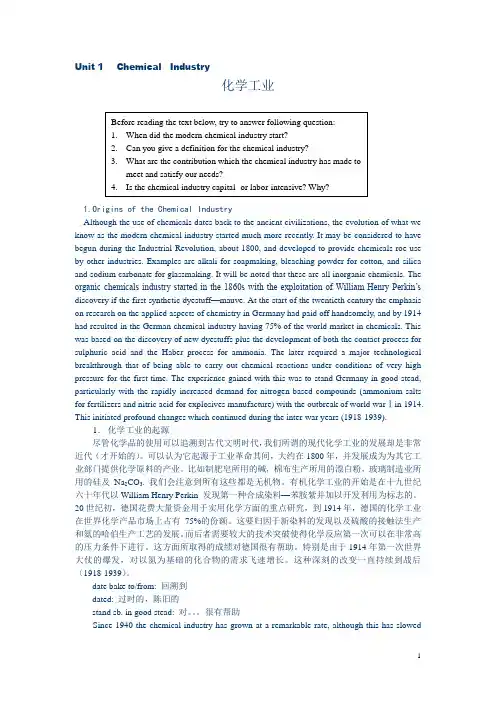
Unit 1 Chemical Industry化学工业1.Origins of the Chemical IndustryAlthough the use of chemicals dates back to the ancient civilizations, the evolution of what we know as the modern chemical industry started much more recently. It may be considered to have begun during the Industrial Revolution, about 1800, and developed to provide chemicals roe use by other industries. Examples are alkali for soapmaking, bleaching powder for cotton, and silica and sodium carbonate for glassmaking. It will be noted that these are all inorganic chemicals. The organic chemicals industry started in the 1860s with the exploitation of William Henry Perkin’s discovery if the first synthetic dyestuff—mauve. At the start of the twentieth century the emphasis on research on the applied aspects of chemistry in Germany had paid off handsomely, and by 1914 had resulted in the German chemical industry having 75% of the world market in chemicals. This was based on the discovery of new dyestuffs plus the development of both the contact process for sulphuric acid and the Haber process for ammonia. The later required a major technological breakthrough that of being able to carry out chemical reactions under conditions of very high pressure for the first time. The experience gained with this was to stand Germany in good stead, particularly with the rapidly increased demand for nitrogen-based compounds (ammonium salts for fertilizers and nitric acid for explosives manufacture) with the outbreak of world warⅠin 1914. This initiated profound changes which continued during the inter-war years (1918-1939).1.化学工业的起源尽管化学品的使用可以追溯到古代文明时代,我们所谓的现代化学工业的发展却是非常近代(才开始的)。
Unit 10 What Is Chemical Engineering?什么是化学工程学In a wider sense, engineering may be defined as a scientific presentation of the techniques and facilities used in a particular industry. For example, mechanical engineering refers to the techniques and facilities employed to make machines. It is predominantly based on mechanical forces which are used to change the appearance and/or physical properties of the materials being worked, while their chemical properties are left unchanged. Chemical engineering encompasses the chemical processing of raw materials, based on chemical and physico-chemical phenomena of high complexity.广义来讲,工程学可以定义为对某种工业所用技术和设备的科学表达。
例如,机械工程学涉及的是制造机器的工业所用技术和设备。
它优先讨论的是机械力,这种作用力可以改变所加工对象的外表或物理性质而不改变其化学性质。
化学工程学包括原材料的化学过程,以更为复杂的化学和物理化学现象为基础。
Thus, chemical engineering is that branch of engineering which is concerned with the study of the design, manufacture, and operation of plant and machinery in industrial chemical processes.因此,化学工程学是工程学的一个分支,它涉及工业化化学过程中工厂和机器的设计、制造、和操作的研究。
Unit 1 Chemical Industry化学工业1.Origins of the Chemical IndustryAlthough the use of chemicals dates back to the ancient civilizations, the evolution of what we know as the modern chemical industry started much more recently. It may be considered to have begun during the Industrial Revolution, about 1800, and developed to provide chemicals roe use by other industries. Examples are alkali for soapmaking, bleaching powder for cotton, and silica and sodium carbonate for glassmaking. It will be noted that these are all inorganic chemicals. The organic chemicals industry started in the 1860s with the exploitation of William Henry Perkin’s discovery if the first synthetic dyestuff—mauve. At the start of the twentieth century the emphasis on research on the applied aspects of chemistry in Germany had paid off handsomely, and by 1914 had resulted in the German chemical industry having 75% of the world market in chemicals. This was based on the discovery of new dyestuffs plus the development of both the contact process for sulphuric acid and the Haber process for ammonia. The later required a major technological breakthrough that of being able to carry out chemical reactions under conditions of very high pressure for the first time. The experience gained with this was to stand Germany in good stead, particularly with the rapidly increased demand for nitrogen-based compounds (ammonium salts for fertilizers and nitric acid for explosives manufacture) with the outbreak of world warⅠin 1914. This initiated profound changes which continued during the inter-war years (1918-1939).1.化学工业的起源尽管化学品的使用可以追溯到古代文明时代,我们所谓的现代化学工业的发展却是非常近代(才开始的)。
1 Unit5元素周期表As our picture of the atom becomes more detailed 随着我们对原子的描述越来越详尽,我们发现我们陷入了进退两难之境。
有超过100多中元素要处理,我们怎么能记的住所有的信息?有一种方法就是使用元素周期表。
这个周期表包含元素的所有信息。
它记录了元素中所含的质子数和电子数,它能让我们算出大多数元素的同位素的中子数。
它甚至有各个元素原子的电子怎么排列。
最神奇的是,周期表是在人们不知道原子中存在质子、中子和电子的情况下发明的。
Not long after Dalton presented his model for atom( )在道尔顿提出他的原子模型(原子是是一个不可分割的粒子,其质量决定了它的身份)不久,化学家门开始根据原子的质量将原子列表。
在制定像这些元素表时候,他们观察到在元素中的格局分布。
例如,人们可以清楚的看到在具体间隔的元素有着相似的性质。
在当时知道的大约60种元素中,第二个和第九个表现出相似的性质,第三个和第十个,第四个和第十一个等都具有相似的性质。
In 1869,Dmitri Ivanovich Mendeleev,a Russian chemist, 在1869年,Dmitri Ivanovich Mendeleev ,一个俄罗斯的化学家,发表了他的元素周期表。
Mendeleev通过考虑原子重量和元素的某些特性的周期性准备了他的周期表。
这些元素的排列顺序先是按原子质量的增加,,一些情况中, Mendeleev把稍微重写的元素放在轻的那个前面.他这样做只是为了同一列中的元素能具有相似的性质.例如,他把碲(原子质量为128)防在碘(原子质量为127)前面因为碲性质上和硫磺和硒相似, 而碘和氯和溴相似.Mendeleev left a number of gaps in his table.Instead of Mendeleev在他的周期表中留下了一些空白。
01 元素和元素周期表The number of protons in the nucleus of an atom is referred to as the atomic number, or proton number, Z. The number of electrons in an electrically neutral atom is also equal to the atomic number, Z. The total mass of an atom is determined very nearly by the total number of protons and neutrons in its nucleus. This total is called the mass number, A. The number of neutrons in an atom, the neutron number, is given by the quantity A-Z.原子核内的质子数被称为原子序数,或质子数,Z。
一个电中性原子的电子数量也等于原子序数,Z。
原子的总质量接近核内质子数和中子数之和。
这个总数被称为质量数A。
中子在一个原子中的数量,中子数,给出了的数量为A-Z。
The term element refers to, a pure substance with atoms all of a single kind. To the chemist the "kind" of atom is specified by its atomic number, since this is the property that determines its chemical behavior. At present all the atoms from Z = 1 to Z = 107 are known; there are 107 chemical elements. Each chemical element has been given a name and a distinctive symbol. For most elements the symbol is simply the abbreviated form of the English name consisting of one or two letters, for example:单质是指,一个纯物质由一种原子组成的。
化学家认为这种原子由它的原子数决定,因为它的性质决定了其化学行为。
目前所有被知道的原子是Z = 1 到Z = 107的的原子,有107种化学元素。
每一种化学元素被给以一个名字和一个独特的符号。
对于大多数元素符号都仅仅是英文名称缩写为一个或两个字母,例如: oxygen==O nitrogen == N neon==Ne magnesium == Mg氧=O 氮=N 氖=Ne 镁=MgSome elements,which have been known for a long time,have symbols based on their Latin names, for example:一些元素,很久以前就被知道的,它们的符号根据他们的拉丁名字符号,例如: iron==Fe(ferrum) copper==Cu(cuprum) lead==Pb(plumbum)铁= =Fe(ferrum) 铜= =Cu(cuprum) 铅= =Pb(plumbum)A complete listing of the elements may be found in Table 1.一个完整的元素表可以被发现于表1。
Beginning in the late seventeenth century with the work of Robert Boyle, who proposed the presently accepted concept of an element, numerous investigations produced a considerable knowledge of the properties of elements and their compounds1. In 1869,D.Mendeleev and L. Meyer, working independently, proposed the periodic law. In modern form, the law states that the properties of the elements are periodic functions of their atomic numbers. In other words, when the elements are listed in order of increasing atomic number, elements having closely similar properties will fall at definite intervals along the list. Thus it is possible to arrange the list of elements in tabular form with elements having similar properties placed in vertical columns2. Such an arrangement is called a periodic table。
在十七世纪后期开始,在工作罗伯特·波以耳,提出当前公认的元素概念,大量的研究产生元素性质及其化合物的知识。
在1869年,D.Mendeleev和L. Meyer,独立工作,提出了周期性的律法。
在现代形式,法律规定的元素的性质是原子序数的周期函数。
换句话说,当元素的按原子序数增加列清单,有相近的特性的元素落在了明确的间隔在清单上有明确间隔。
于是,将具有类似性质的元素排成纵列,从而把元素排成表格形式是可能的。
这样的安排被称为一个周期表。
Each horizontal row of elements constitutes a period. It should be noted that the lengths of the periods vary. There is a very short period containing only 2 elements, followed by two short periods of 8 elements each, and then two long periods of 18 elements each. The next period includes 32 elements, and the last period is apparently incomplete. With this arrangement, elements in the same vertical column have similar characteristics. These columns constitute the chemical families or groups. The groups headed by the members of the two 8-element periods are designated as main group elements, and the members of the other groups are called transition or inner transition elements.每个水平排的横列元素构成一个周期。
但应该注意的是周期不同长度的。
非常短的周期只包含两种元素,后面跟着两个短周期每个含8元素,然后两个长周期每个由18个元素组成。
下一个周期包含32元素,最后一个周期明显不完整的。
这样的安排,元素在同一纵列有相似的特性。
这些纵列构成化学家庭或组。
为首的两个8元素周期的成员被选定作为主族元素,其他组的成员被称为过渡或内在过渡元素。
In the periodic table, a heavy stepped line divides the elements into metals and nonmetals. Elements to the left of this line (with the exception of hydrogen) are metals, while those to the right are nonmetals. This division is for convenience only; elements bordering the line—the metalloids-have properties characteristic of - both metals and nonmetals. It may be seen that most of the elements, including all the transition and inner transition elements, are metals.在元素周期表中,沉重的阶梯的线把元素分为金属和非金属元素。
那条线的左边(除氢)是金属,而那些右边是非金属矿物等。
这条线划分只是为了方便。
那些与分隔线相临近的元素——准金属,既有金属的性质,又有非金属的性质。
可以看出,大部分的元素,是金属元素。
Except for hydrogen, a gas, the elements of group IA make up the alkali metal family. They are very reactive metals, and they are never found in the elemental state in nature. However, their compounds are widespread. All the members of the alkali metal family, form ions having a charge of 1+ only. In contrast, the elements of group IB —copper, silver, and gold—are comparatively inert. They are similar to the alkali metals in that they exist as 1+ ions in many of their compounds. However, as is characteristic of most transition elements, they form ions having other charges as well.除了氢元素——一种气体元素外,ⅠA族的元素组成了碱金属。